Strawberry IPM Newsletter No. 1- May 21, 2021
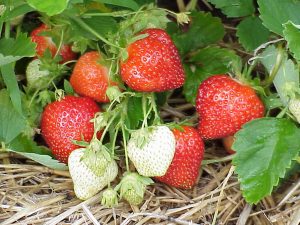 University of Maine Strawberry IPM Newsletter No. 1- May 21, 2021
University of Maine Strawberry IPM Newsletter No. 1- May 21, 2021
Click on photos to enlarge
2021 STRAWBERRY PEST MANAGEMENT SEASON BEGINS
Twilight Meeting June 9, 2021, 6 p.m., at Jordan’s Farm, Cape Elizabeth
Situation:
A cool start to the spring had things looking like strawberries might get off to a late start, but recent warm weather has sped development along, and now we may be looking at an early harvest in much of the state. Overall, the winter was not too harsh on most fields, although high winds during the coldest months may have caused injury where protective mulch had blown off. Early flowering varieties such as Wendy, are showing a few blossoms to nearly full bloom in matted rows, depending on location. Growers using plasticulture and row covers may have plants in bloom to petal fall. There has been a little frost injury noticed on early varieties, but nothing severe. No frost warnings for the next week, but growers should still be vigilant and be prepared to frost-protect their plants, if necessary.
As we approach our second picking season of the COVID-19 pandemic, we continue to adapt to follow CDC Guidelines, and governmental restrictions put in place to reduce its impacts. If you need a refresher in best practices for managing pick-your-own and produce sales under these conditions, there are several resources available. Cornell University, in cooperation with the other Northeast states has a very helpful guide: guide “Best Management Practices for U-Pick Farms During the COVID-19 Pandemic”. This has been reviewed by the Maine Department of Agriculture, Forestry and Conservation, and approved for adoption by Maine Farmers, with an addendum of Maine-specific regulations and suggestions. Free downloads of the publications are available here
I have begun scouting strawberry fields for overwintering insect pests, disease issues and winter injury last week. Under our present COVID-19 guidelines, the number of sites I can visit are still restricted, so I am limited to just a few visits per week. I would be happy to add any pest situation developing in your fields to the Newsletter in order to keep your fellow growers informed. The results of my strawberry scouting will be reported through this newsletter until harvest time. You can also get quick access to this information through the UMaine Highmoor Farm news blog or the UMaine Pest Management web page. If you have questions about the Newsletter, please give us a call at 207.933.2100 or send an e-mail message to Caitlin Ramsay at: caitlin.ramsay@maine.edu (email is preferred)
Spring Growers’ Twilight Meeting
The Maine Vegetable & Small Fruit Growers Association will be having a Spring Twilight Meeting on Wednesday, June 9, at 6 pm at Jordan Farm, 21 Wells Road, Cape Elizabeth. We will have the usual strawberry update and a discussion of how things went last year for pick-your-own operations under the COVID restrictions. In addition, there will be a tour of Jordan Farm’s new storage building that was built with an NRCS grant, a discussion of the current labor situation, and a talk about interseeding cover crops by Cumberland County Extension agent Jason Lilly. Hope to see you there!
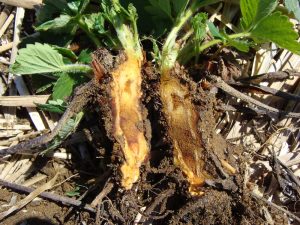
Winter injury:
Plants may be victims of winter injury if they appear weak or dead: especially in more exposed parts of a field, where mulch was not applied or where mulch was displaced by wind or animals. This is caused by freezing of the tissue in the crown of the plants, and therefore can be diagnosed by cutting into the crowns of the strawberry plants. The internal tissue will show dark brown discoloration. To reduce the impact of winter injury, make sure the plants get plenty of water, and apply nutrients to encourage root growth and flower development, which should include: nitrogen, calcium, and phosphorus. Heavy nitrogen fertilizer applications in the spring are not recommended, but up to 20 pounds of actual N (e.g. 125 lb. calcium nitrate) may improve early spring growth. I have also seen some deer damage to overwintering crowns, and received reports of vole damage from other northeast states.
Spring Weed Management:
Some growers were not able to make their typical dormant fall herbicide applications due to the early snowfall. Herbicides available for spring applications are much more limited due to concerns about plant injury and harvest intervals. Dacthal® and Devrinol® herbicides are registered for use in the spring and can be very effective on annual grasses and some broadleaf weeds, but only have pre-emergent activity, i.e. will not control weeds already emerged. Other herbicides have some post emergent activity but may only be applied with a shielded sprayer to the areas between the plant rows, not directly over the plants, or injury is likely to occur. These materials include Chateau®, Prowl H2O®, Satellite Hydrocap®, and Aim®.
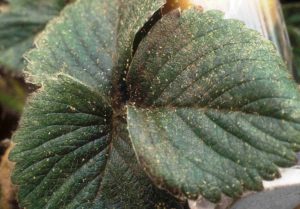
Two-spotted spider mites can be a problem in the spring, especially for plants under row covers. I have only found one field this spring with high mite populations, but I expect this pest will be a concern for more growers as temperatures rise. Mites reproduce rapidly when warm weather arrives, so it is important to scout for them regularly. Spider mites mostly feed on the undersides of strawberry leaves by rasping the plant tissue and sucking the sap. Infested leaves will develop yellow flecking and a bronzed appearance. The plants will become weakened and stunted. Fields that have had excessive nitrogen fertilizer and/or row covers tend to be most susceptible to mite injury. To scout for mites, collect 60 leaves from various locations in the field and examine the undersides for the presence of mites. Mites are very small – you may need a hand lens to see them. Chemical control options for two-spotted spider mites include Acramite®, Portal®, Nealta® Savey®, Zeal®, Vendex®, Oberon®, Brigade®, Danitol® and JMS Stylet Oil® (oils will cause plant injury if used in combination with captan or within 14 days of an application of sulfur).
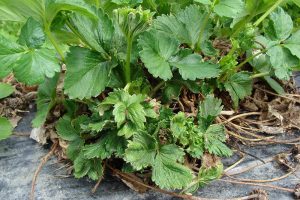
Cyclamen mites:
I have seen some evidence of cyclamen mite injury in fields this spring. Plants showing weak growth and yellow, pinkish or blackened, crinkled leaves may be infested. These mites are very small, smaller than spider mites, and reside in the crown of the strawberry plant feeding on the developing leaves and flower buds. They are very hard to see, even with magnification. Infested plants have: shrunken-distorted leaves and flower stalks, and produce few to no marketable fruit. The miticide Portal® can be effective, but must be applied in lots of water and a spreader adjuvant to be sure that the material is carried down into the crowns where these mites reside. Often, miticides applications are more effective during renovation, after the leaves have been mowed off, to better get the sprays down into the crowns.
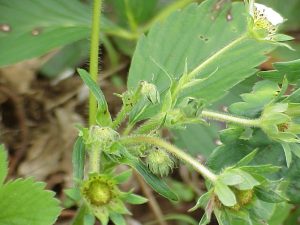
Strawberry bud weevil:
There has been some damage from “clippers” this week. Affected flower buds are clipped below the base and dangle from their stems looking wilted and brown. The small weevil that causes the damage can often be found amongst the flower clusters, laying eggs and feeding on pollen. Once the buds have opened these insects can no longer cause significant injury. Clippers have been active in most fields that I’ve scouted this week, but some early fields are already beyond the bud stage where the clipper can cause damage. The control threshold for clipper injury is more than 1.2 clipped buds per two feet of row. Small holes in the petals of opening flowers indicates clipper feeding activity, and is often first noticed in the border rows. Expect clipper damage to be most common in later blooming varieties now beginning to flower. Insecticide options for clippers include Lorsban®, Brigade®, Bifenture®, Danitol®, Sevin® and PyGanic®. Clippers will also attack the buds of raspberries and blackberries, although they do not usually cause significant injury.
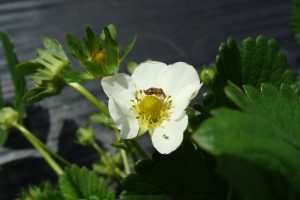
Tarnished plant bug activity has also been noted this week, with both adult and nymph stages present in some fields, but none yet over the control threshold. The nymphs can be hard to find, especially if the plants are wet. Young nymphs are very small (2 mm), active, yellow-green insects. It is important to scout for them regularly, as they may appear very quickly as the weather improves. The threshold for plant bug nymphs is 4 or more flower clusters infested per 30 sampled. You don’t have to count the nymphs; just tap flower clusters over a plate or tray to knock any nymphs off. If any appear on the plate after tapping, count that cluster as “infested”. Start scouting any field with open flowers now. Insecticide options for tarnished plant bugs include malathion, Assail®, Brigade®, Bifenture®, Dibrom®, Danitol®, and PyGanic®.
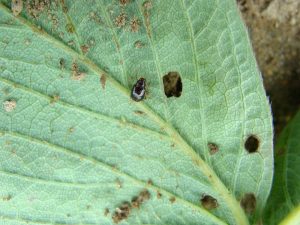
Root weevil management
Fields that were infested with root weevils last summer should be inspected for grubs this spring. Infested plants will appear weak and stunted, usually in somewhat circular patches in a field. Digging under the plants will reveal small (1/4”-1/2”) crescent-shaped legless grubs. Typically, the grubs begin to pupate when the plants are in bloom. A soil drench of Platinum® (thiamethoxam) insecticide during the spring and/or fall when the grubs are active in the soil can provide control. However, Platinum® has a 50 day pre-harvest interval, so it is too late for applications in most fruiting fields this year. Platinum® may also be used as a pre-plant or planting treatment for root weevils. It is not too late to put on an application of nematodes to control the grubs (optimal timing is mid-late May). Two species of nematodes appear to offer the best control of root weevil grubs. Heterorhabditis bacteriophora (Hb) appears to be the best candidate for control of root weevils when the soil temperature is above 60 degrees, and is available from: Green Methods Integrated Biocontrol Network, and Koppert Biological Systems.
Order nematodes ahead of time and be ready to apply them through a sprayer or irrigation soon after they arrive. Do not apply nematodes using a sprayer with a piston pump. Use clean equipment, removing all screens finer than 50-mesh. Apply nematodes in the early morning or in the evening in a high volume of water to already moist soil, pre-irrigate if needed. Apply another 1/4 inch of irrigation after application to wash them onto and into the soil. Researchers and suppliers recommended 250 (if banded in the row) to 500 million per acre, at a cost of $100-$200 per acre depending on volume and source. Nematodes tend to work best in heavily infested fields. Strawberry plants can recover their vigor remarkably well if crown feeding has not occurred and diseases haven’t taken over the roots.
Once the adults become active in July, bifenthrin (Brigade®) will provide some control if used at the highest labeled rates. The best timing for this spray is at night during the peak feeding activity of adults, before they start laying eggs, or about the time harvest ends.
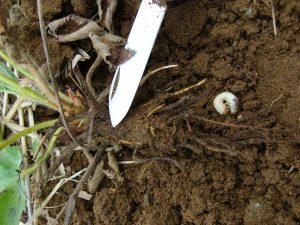
White grubs:
Weak growth noted in fields this spring may also be the result of white grubs feeding on the roots of newer plantings. These grubs are the larvae of beetles, including European chafer and Asiatic garden beetle. They differ from the larvae of black vine weevil and strawberry root weevil in that they have legs and a swollen anterior (rear end), and they tend to be larger. Their feeding weakens the plants by reducing the number of roots. The grubs can be found by pulling up weak plants and sifting through the soil that surrounds the roots. Controlling white grubs once they have become established in a field can be difficult. These tend to be more of a problem in new fields that have been planted following a grass rotation crop, because the adults prefer to lay their eggs in sod. Admire Pro® and Platinum® insecticides are labeled for control of white grubs and should be applied within two hours of irrigation or rainfall to be sure the chemical gets into the root zone. Admire Pro® requires a 14 day to harvest interval, while Platinum® requires a 50-day pre-harvest interval.

Diseases:
Bloom is a critical time to protect strawberry fruit against gray mold caused by the fungus Botrytis cinerea, especially when conditions have been damp. Two to three sprays of fungicide during bloom are typically required to provide good protection against this disease. Botrytis cinerea overwinters on old leaves and plant debris. Fruit infections take place almost exclusively through the flowers, so gray mold control efforts must be focused on the bloom period. If the bloom period is dry and/or good fungicide coverage is maintained, incidence of gray mold at harvest should be low.
There are several excellent fungicide choices for control of gray mold in strawberries. Elevate® (fenhexamid) has good to excellent activity against Botrytis. Captevate® is a pre-mix of captan and fenhexamid and has a broader spectrum of activity than Elevate® alone. Switch® (cyprodinil and fludioxonil), Scala® (pyramethanil) and Pristine® (pyraclostrobin and boscalid) are also excellent products for gray mold control. Topsin M® + captan is also a good fungicide combination, but remember that captan is strictly a protectant and can be washed off by rain or irrigation water. Thiram is similarly effective, but also susceptible to wash-off.
The fungicides Cabrio® (pyraclostrobin) and Abound® (azoxystrobin) are NOT suitable for gray mold control, but are effective against anthracnose and other fruit rot and leaf spot diseases. All fungicides mentioned above have a 0-day pre-harvest interval, except Topsin M® (1 day) and thiram (3 days). Remember to alternate fungicides with different modes of action for resistance management purposes.
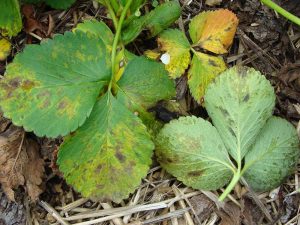
Angular leaf spot is a bacterial disease that is characterized by translucent leaf spots that may turn yellow and eventually black. The symptoms tend to start on the lower leaves but may move upwards as bacterial spores are splashed up by rain or irrigation water. Infection of the calyxes may result in a blackening of the berry stems and caps, reducing their marketability. Bacterial angular leaf spot is favored by extended cool, wet weather and nights with temperatures close to freezing. Frequent irrigation for frost protection can greatly encourage the development and spread of the disease, as will extended cool, damp weather. Susceptibility to this disease appears to vary significantly between varieties. The copper-containing material Kocide®, can reduce the spread of this disease. Start spray applications before bloom to prevent multiplication of the bacteria on the leaves before they jump to the berry caps. Application of copper sprays after bloom can result in fruit injury and is not recommended. Hydrogen dioxide (OxiDate®) may also have some activity against angular leaf spot when used on strawberries as part of a gray mold management program.
 Highbush blueberries are showing some winter injury on last year’s growth. This appears as a dark brown or black discoloration on the shoots. The damage is usually limited to growth above the snowline. The cool, wet weather has initiated the release of mummy berry spores from the overwintering mummies. Expect infection periods to continue over the next couple of weeks, anytime there is a significant moisture event (rain, mist, fog). Protectant fungicides for mummy berry should be applied once the flower buds have begun to expand. Registered materials include Indar®, Orbit®, and Quilt Excel®.
Highbush blueberries are showing some winter injury on last year’s growth. This appears as a dark brown or black discoloration on the shoots. The damage is usually limited to growth above the snowline. The cool, wet weather has initiated the release of mummy berry spores from the overwintering mummies. Expect infection periods to continue over the next couple of weeks, anytime there is a significant moisture event (rain, mist, fog). Protectant fungicides for mummy berry should be applied once the flower buds have begun to expand. Registered materials include Indar®, Orbit®, and Quilt Excel®.
2021-2022 New England Small Fruit Management Guides The latest edition of the Guide will be available online soon at:
UMass N.E. Small Fruit Management Guide.
A printed version of the guide is being formatted and should be available early this summer.
The best way to manage strawberry pests is to scout your own fields regularly and often. You should begin to scout as soon as flower buds emerge from the crowns and continue to monitor the plantings one or two times per week up until harvest.
Sincerely,
David T. Handley
Vegetable and Small Fruit Specialist
Highmoor Farm Pest Management Unit
P.O. Box 179 17 Godfrey Dr.
Monmouth, ME 04259 Orono, ME 04473
207.933.2100 1.800.287.0279
Where brand names or company names are used, it is for the reader’s information. No endorsement is implied nor is any discrimination intended against products with similar ingredients. Always consult product labels for rates, application instructions and safety precautions. Users of these producers assume all associated risks.
The University of Maine is an equal opportunity/affirmative action institution.
